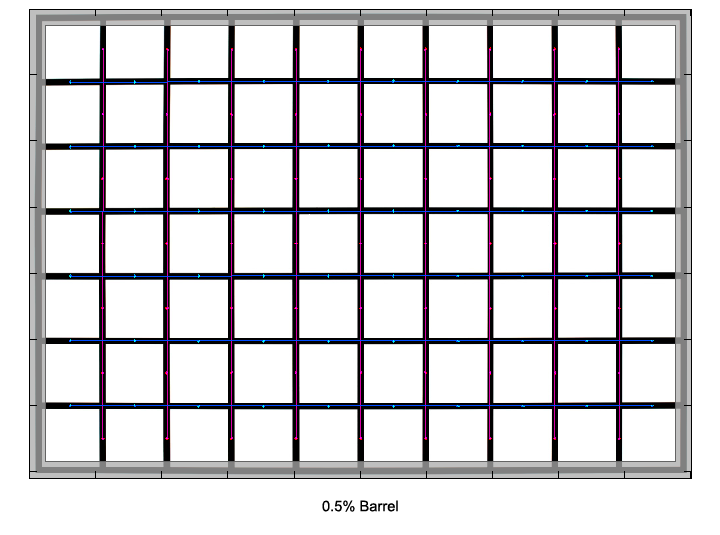|
Page 2 of 2

Distortion
The lens shows a vey small amount of barrel distortion on DX cameras.

The chart above has a real-world size of about 120x80cm.
Vignetting
Since the lens is designed for much larger sensors, vignetting is well controlled on a DX-sized sensor. Wide open, the amount of light fall-off towards the corners can be visible and disturbing, but it's still moderate for such a fast lens. As usual, stopping down reduces the amount of vignetting considerably. From f/2 onwards, it is no longer an issue for most subjects.

MTF (resolution)
In the image center, the lens delivers very good resolution wide open and excellent figures stopped down.
The image borders start out lower, with good resolution wide open and at f/2. Stopping down further lifts the values to very good levels from f/2.8 onwards and even excellent resolution at f/5.6 and f/8.
The extreme corners are just fair wide open. Stopping down lifts the resolution to good values and very good resolution at f/5.6 and beyond.
It is worth mentioning that the lens showed no focus shift when stopping down (residual spherical aberration).
Please note that the MTF results are not directly comparable across the different systems!
Below is a simplified summary of the formal findings. The chart shows line widths per picture height (LW/PH) which can be taken as a measure for sharpness.
If you want to know more about the MTF50 figures you may check out the corresponding Imatest Explanations

Chromatic Aberrations (CAs)
Chromatic aberrations (color shadows at harsh contrast transitions) are well controlled and show only moderate values of around 1 pixel at the image borders.

Bokeh
One of the primary usage scenarios for a large aperture lens is to seperate the main subject from the background. In such an image the quality of the bokeh (out-of-focus blur) is of major significance.
The lens generally delivers quite smooth bokeh, especially for a wide angle prime. In our test scene below the Sigma shows a tad of nervousness in the transition zone. During our field tests we noticed this also at medium aperture settings with subjects in the distant background (see the sample images in our FX review of the lens).
Thanks to 9 rounded aperture blades, background highlights retain their circular shape throughout the whole aperture range. There is almost no outlining in the disks formed by highlights, in fact the blur is evenly distributed.

Bokeh Fringing
Bokeh fringing is a common issue with relatively fast glass. It's visible as halos of different colors in out-of-focus areas - magenta (red + blue) in front of the focus point and green beyond.
Typical for most fast primes, especially ultra fast ones, the Sigma shows some amount of bokeh fringing at large aperture settings, which can of course be reduced by stopping down.
In addition, these shots also illustrate that there is no focus shift when stopping down, as it was already mentioned in the MTF section.
Sample Shots
You can find some sample images taken with the Nikon D3x in our Nikon FX review of the lens.
VerdictThe Sigma 35mm f/1.4 shows decent performance on the D7000. The center resolution is very high, while the borders and especially the corners are a bit soft wide open. The lens needs to be stopped down considerably to delivery very good resolution across the frame.
Distortion is no issue on DX cameras. Vignetting is a bit pronounced wide open, but that's typical behaviour for such a fast lens. Stopping down slightly easily resolves this issue. Typical for a fast prime, some bokeh fringing is present at larger apertures. The bokeh is quite smooth for a lens in this class.
Thanks to a HSM drive, the AF is silent and very fast and the lens is compatible with all Nikon DSLRs, including the enty-level DX models.
A very positive surprise is the build quality of the lens. It feels like a premium product. Talking about "premium": while the Sigma is more affordable than its main competition, it's still an expensive lens in absolute terms, retailing at around 850 EUR at the time of this review.
On DX, this is probably the biggest issue of the lens: there are dedicated DX primes with similar specifications, like the Sigma 30/1.4 DC or Nikon's AF-S DX 35/1.8, which do not necessarily deliver the same performance in every regard, but cost only a fraction of the Sigma 35mm f/1.4.
|